Pace
J-ashi (ðë), C-bu (ÜÆ), K-¹ß
The speed at which important points on the board are occupied.
There are Japanese and Korean expressions ¡®ashi ga hayai (J)¡¯ and ¡®¹ßÀÌ ºü¸£´Ù (K)¡¯ meaning literally ¡®the pace is fast,¡¯ and ¡®ashi ga osoi (J)¡¯ and ¡®¹ßÀÌ ´À¸®´Ù¡¯ meaning ¡®the pace is slow.¡¯
Paired moves
J-miai (̸ùê), C-jianhe (?ùê), K-¸Âº¸±â
1. Two moves that can serve for the same purpose.
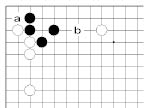 Dia. 1
Dia. 1
In Dia. 1, ¡®a¡¯ and ¡®b¡¯ are equivalent because they both work to settle the black stones in the corner.
2. Two moves that can get almost the same amount of profit though the purpose they serve is not the same.
 Dia. 2
Dia. 2
White 1 in Dia. 2 aims at both starting a ko at ¡®a¡¯ and invading at ¡®b,¡¯ and the expected profits from each of them are almost the same. So in this sense, ¡®a¡¯ and ¡®b¡¯ are paired.
Pass
No J, C-fangqizhuoshou (ۯѥó·â¢), K-Âø¼öÆ÷±â(ó·â¢øÛÑ¥)
To give up one¡¯s turn to play.
The player who says ¡®pass¡¯ cannot play until the opponent makes a move. If the opponent also passes, then the game is ended.
Pattern
J-joseki (ïÒà´), C-dingshi (ïÒãÒ), K-Á¤¼® (ïÒà´)
A formulaic sequence of moves which is established for giving equal outcomes to both players.
Actually, the concept of ¡®pattern¡¯ does not indicate just one pattern, but also a group of patterns that share characteristics or a core move.
 Dia. 1
Dia. 1
The sequence shown in Dia.1 is one of the most popular patterns played in professional Go. In this pattern, White¡¯s profit and Black¡¯s influence have the same value.
Peep
J-nozoki (ØЪ), C-dian/ci (ïÃ/í©), K-µé¿©´Ù º¸´Ù
A move that is made adjacent to a cutting point and threatens to cut.
The diagrams below show several examples of peeping plays that aim at the cutting point ¡®a¡¯.
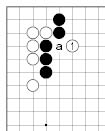 Dia. 1
Dia. 1 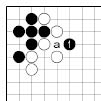 Dia. 2
Dia. 2
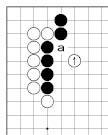 Dia. 3
Dia. 3  Dia. 4
Dia. 4
Picnic ko
J-hanami ko (ü£Ì¸Ì¤), C-wuyou jie (Ùé?̤), K-²É³îÀÌ ÆÐ
A ko where one player will not be damaged even if he loses it, while the other will be damaged more seriously.
 Dia. 1
Dia. 1
For the side that has nothing to lose, it is the best type of ko possible, because anything he gains from it will be to his benefit and he riskes nothing. The ko in Dia. 1 is a picnic ko for White. The Japanese ¡®hanami(ü£Ì¸)¡¯ and the Korean ¡®²É³îÀÌ¡¯ mean ¡®flower-viewing,¡¯ which comes from the spring picnic where people drinks rice wine under the cherry blossom. The Chinese ¡®wuyou(Ùé?)¡¯ means ¡®no worry.¡¯
Pincer
J-hasami (úóªß), C-jia (?), K-Çù°ø(úóÍô)
A play move attacks an enemy stone from both sides as Black 1 does in combination with the marked black stone in Dia. 1.
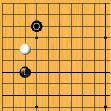 Dia. 1
Dia. 1
One-space pincer Two-space pincer Three-space pincer



Counter-pincer
J-hasami kaeshi (úóªßÚ÷ª·), C-fan jia (Úã?), K-µÇÇù°ø
A pincer that made against the opponent¡¯s pincer
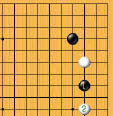 Dia. 1
Dia. 1  Dia. 2
Dia. 2
White 2 in the two diagrams above are counter-pincers.
Placement
J-jyakushu (ó·â¢), C-zhuo shou (ó·â¢), K-Âø¼ö(ó·â¢)
To put a stone on the board as a move in a game.
Strictly speaking, all the moves in Go are not ¡®move¡¯ but ¡®placement. They don¡¯t actually move as the Chess pieces move from their previous location, but are picked from a bowl and newly placed on the board. Even, it is illgal to move a stone after it is placed except when it taken off from the board.
Play elsewhere
J-tenuki (â¢Úûª), C-tuoxian (?à»), K-¼Õ»©´Ù
To ignore the opponent¡¯s last move and make a move in another part of the board.
The Japanese and the Korean terms literally mean ¡®take the hand away.¡¯
Play inside
J-nakade (ñéâ¢), C-dian yan (ïÃäÑ), K-Ä¡Áß (öÇñé)
To place a stone in the middle of an opposing group¡¯s eye shape in order to prevent the opponent from forming two separate eyes.
 Dia. 1
Dia. 1
White 1 in Dia. 1 hits the vital point of the black stones in the corner and so kills them.
 Dia. 2
Dia. 2
However, playing inside doesn¡¯t necessarily mean that the move will always kill the opponent¡¯s stones. It is a move that makes the opponent¡¯s settlement not impossible, but difficult. White 1 in Dia. 2 hits the vital point but Black still has a chance to save his group with ko or dual life.
The Chinese character ¡®ñé,¡¯ usually means ¡®the middle¡¯ or ¡®inside¡¯ and ¡®äÑ¡¯ means ¡®eye shape.¡¯ So the literal meaning of those three terms is ¡®put a stone inside of an eye shape.¡¯
Point
J-ten ïÃ, C-dian (ïÇ), K-Á¡(ïÇ)
An intersection where two lines meet.
This is where stones are played and it is also the unit by which territory is counted.
Ponnuki
J-ponnuki («Ý«ó?ª), C-bahua (Úûü£), K-»§µû³¿
A move that captures an opposing stone with only four stones.
 Dia. 1
Dia. 1
The resulting shape of this move radiates influence in all directions, so it is considered a very good one. There is a proverb that says ¡®A ponnuki is worth thirty points.¡¯
 Dia. 2
Dia. 2
Strictly speaking, if White has the marked stone as in Dia. 2, it is not a ¡®ponnuki,¡¯ though it is called one in practice.
The ¡®pon-¡¯ in the Japanese term and ¡®»§-¡¯ in Korean term are onomatopoeic words describing a hitting sound, and ¡®-nuki¡¯ and ¡®µû³¿¡¯ are words that mean ¡®taking off.¡¯ The Chinese ¡®ba hua (Úûü£)¡¯ means ¡®taking off to make a flowerlike shape.¡¯
Positional judgment
J-, C-xingshi panduan (û¡?÷÷?), K-Çü¼¼ÆÇ´Ü (û¡á§÷÷Ó¨)
Evaluating the state of the game or estimating the territorial balance.
Cf. overall position
Potential erasure
See potential trouble.
Potential trouble
J-aji (Ú«), C-weidao (Ú«Ô³), K-¸À, µÞ¸À
Unpleasant possibilities remaining for one player in a position, after a local sequence has been played out.
The potential trouble is not for immediate but for later use.
Literally ¡®aji,¡¯ ¡®weidao,¡¯ and ¡®¸À¡¯ mean ¡®taste.¡¯
The corner white stones in Dia. 1 have ¡®potential trouble¡¯ at ¡®a.¡¯ White cannot block with 2 in Dia. 2 because then Black will push up with 3 and cut with 5. It is inevitable for White to just connect at 2, as shown in Dia. 3 but, after Black goes over with 3, White has to worry about lack of a base.
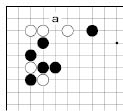 Dia. 1
Dia. 1 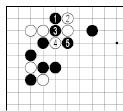 Dia. 2
Dia. 2 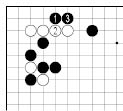 Dia. 3
Dia. 3
Potential trouble is always unpleasant. If there is potential trouble, it works unfavorably for the player who has it in his shape or framework. Therefore the most correct expression about potential trouble should be like ¡®there is potential trouble in Black¡¯s position,¡¯ or ¡®potential troube remains in Whites framework.¡¯
There are expressions like ¡®û¿/ÝÕû¿¡¯ in Chinese,¡®warrui (䪤)/yoi¡¯ in Japanese and ¡®ÁÁ´Ù/³ª»Ú´Ù¡¯ in Korean which literallt mean ¡®good/bad potential trouble.¡¯ However, they are just rhetorical expressions. When potential trouble is good, that means actually there is not potential trouble, and when potential trouble is bad, that means there is potential trouble.
Potential erasure
J-aji keshi (ګἪ·), no C, no K
A move that looks good because the opponent has to answer it, but actually just removes potential trouble remaining in the opponent¡¯s position.
There is potential trouble of being invaded at ¡®a¡¯ in Black¡¯s territory of Dia. 1. White can take a big profit by playing 1 and 3 in Dia. 2. In this case, if White pushes at 1 as in Dia. 3 because it is sente, it is potential erasure.
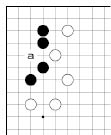 Dia. 1
Dia. 1 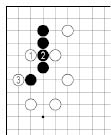 Dia. 2
Dia. 2  Dia. 3
Dia. 3
There is no word equivalent to the Japanese ¡®aji keshi¡¯ in the Korean and the Chinese terminology. Korean ¡®¼ÕÂî°Ë¡¯, which literally means ¡®to hit (the opponent) fruitlessly¡¯, can be a possible translation for it, but actually ¡®¼ÕÂî°Ë¡¯ is just a rhetorical and not a technical word. I think the reason why the Korean and Chinese terminology don¡¯t have a word meaning the same thing is that ¡®aji keshi¡¯ is not a term. It is only a compound of two words ¡®aji¡¯ meaning ¡®taste¡¯ and ¡®keshi¡¯ meaning ¡®erasure¡¯ and the meaning of this word is just the same as what it literally means.
In Korea, there is another kind of getting rid of potential trouble. This is called ¡®°¡Àϼö(ʦìéâ¢)¡¯ which is an additional play to defend a weakness. It differs from ¡®aji keshi¡¯ which affects badly the player who made it. See ¡®extra-defense.¡¯
Press
J- kake (ÎЪ±), C- ya (?), K-´©¸£´Ù
To prevent the opponent¡¯s stones from coming out toward the center by blocking them from above.
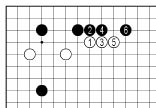 Dia. 1
Dia. 1  Dia. 2
Dia. 2
White 1, 3 and 5 in Dia. 1 and Black 1 and 3 Dia. 2 are pressing the opponent.
Probe
J-Yosumiru (åƪ¹Ì¸ªë), C-shi yingshou (??â¢)£¬K-ÀÀ¼öŸÁø (ëëâ¢öèòà)
A move to see how the opponent will respond.
It is played before one decides the next move.
 Dia. 1
Dia. 1  Dia. 2
Dia. 2  Dia. 3
Dia. 3
White 1 in Dia. 1 sounds out whether Black would play at ¡®a¡¯ or ¡®b.¡¯ If Black answers with ¡®a¡¯, then White cuts with 2 in and takes profit by playing 8 and 10 in sente as in Dia. 2. If Black answers with ¡®b¡¯ then White jumps at 2 as in Dia. 3, being satisfied with the fact that his outside influence has become stronger.
Profit
J-jitsuri (?××), C-shili (?××), K-½Ç¸®(ãù××)
Realized territorial gain
Profit is the opposing concept to influence, which has long range but uncertain effect. While influence is made toward the center where the potential can be most powerful, profit is usually made in the corners and on the sides. The stones making profit are usually located on the 4th line or lower.
Proper move
J-honte (Üââ¢), C-benshou (Üââ¢)£¬K-Á¤¼ö (ïáâ¢)
A play that is correct in a situation, rather than obvious
 Dia. 1
Dia. 1
Black 1 is an example of a proper move. It is not inevitable, but the best move to settle the Black¡¯s position.
Pull back
J-hiki (ìÚª), C-tui (÷Ü)£¬K-²ø´Ù
To draw back in the direction of a friendly stone.
 Dia. 1
Dia. 1
White 1 in Dia. 1 is a pulling back.
Push
J-oshi (ä㪷), C-ya (?), K-¹Ð´Ù
To put a stone at the side of the opponent¡¯s stone from a friendly stone located diagonally behind it
 Dia. 1
Dia. 1
In Dia. 1, White is pushing with 1 and 3. ¡®Push¡¯ is distinguished from ¡®press¡¯ by the fact that the player pushing always has to be one line behind than the one pushed.
In the Chinese terminology, the three cases below have different name individually.
Push up Push down Push along the side
C-tie (?=attach) C-dang (?=block) C-pa (÷ð=crawl)



Qidaizhao
C-ѤÓâ?
An official position setup in China for cultivating the professional players and serving the Emperors with Go during the Tang and Song Dynasties.
Its literature meaning is ¡®to wait for the order of serving the people in the Emperor¡¯s Palace.¡¯ Actually, the qidaizhaos were the earliest professional Go players. The system of qidaizhao was established by the Emperor Xuanzong at the 8th century and the first qidaizhao appeared in the history book is Wang jixin.
Quick game
J-hayago (ðÄѳ), C-kuaiqi (öáѤ), K-¼Ó±â(áÜѤ)
1. A game that is played with a short time limit, usually enforced by the clock. Often called ¡®lightning Go¡¯
2. A game that is played very quickly, not because of the time limit but because the players do not spend much time in thinking.
Rabitty five
J-hana gomoku (ü£çéÙÍ), C-daoba wu (Óï÷êçé), K-¿À±ÃµµÈ (çéÏàÓþü£)
A name for the eye shape of five points shown in Dia. 1.
 Dia. 1
Dia. 1  Dia. 2
Dia. 2
The Chinese ¡®daoba (Óï÷ê)¡¯ means a ¡®handle of a knife used in chopping vegetables¡¯ and the Korean ¡®µµÈ (Óþü£)¡¯ means ¡®flowers of a peach tree.¡¯ The Japanese ¡®hana gomoku¡¯ also refers to the Black¡¯s shape in Dia. 2.
Rectanglular six
J-kushigata (ª¯ª·ª¬ª¿), itaruku (÷ùë»), C-banliu (?׿)£¬K-ÆÇ·ú(?׿)£¬
An eye space made up of two by three points of rectangle.
It is called ¡®six-point plank eye space¡¯ in all three Asian countries. In Japan and Korea it¡¯s also called the ¡®comb shape¡¯ because Black¡¯s shape in Dia. 1 looks like a traditional hair comb.
 Dia. 1
Dia. 1
A rectangular six on a side or in the center is always alive as it stands, but in a corner it can be killed by a move at White 1 as shown in Dia. 3.
 Dia. 2
Dia. 2  Dia. 3
Dia. 3
Reading
J- yomi (?ªß), C-shumu (?ÙÍ)£¬K-¼öÀбâ
To analyze a position and anticipate the results of moves.
Reduce
J-keshi (Ἢ·), C-qianxiao (?á¼), K-»è°¨(ÞûÊõ)ÇÏ´Ù
To prevent the opponent¡¯s territorial framework from expanding by playing moves above it.
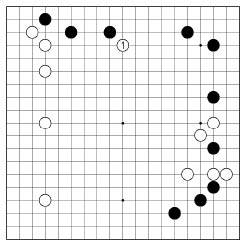 Dia. 1
Dia. 1
White 1 in Dia. 1 reduces Black¡¯s influnce on the upper and the right sides.
Resign
J-toryo (÷áÖõ), C-renshu (??)£¬K-´øÁö´Ù / µ¹À» °ÅµÎ´Ù
To admit the fact that one has lost before the game is actually finished.
Reserve
J-horyu (ÜÁ׺), C-baoliu (ÜÁ׺), K-º¸·ù(ÜÁ׺)ÇÏ´Ù
To leave a local position as it is and wait to see how the situation around it develops before playing .
 Dia. 1
Dia. 1
White can choose to play at ¡®a¡¯ or ¡®b.¡¯ If the upper side is going to be bigger, then he will play at ¡®b¡¯ and if not, he will choose ¡®a¡¯ to live in the corner. Therefore, White doesn¡¯t need to play ¡®a¡¯ or ¡®b¡¯ immediately and can wait until the outside condition is decided. He reserves a move here.
Opp. awaken
Reverse sente
J-gyakusente (æ½à»â¢) / gyakuyose (æ½Ðöª»), C-nishou guanzi (æ½â¥Î¯í)£¬K-¿ª¼±¼ö(æ½à»â¢) / ¿ª³¡³»±â
An endgame move that gives up sente to prevent the opponent from playing a sente endgame.
 Dia. 1
Dia. 1  Dia. 2
Dia. 2
Black 1 in Dia. 1 prevents White from playing 1 and 3 in Dia. 2 in sente.
A reverse sente endgame is usually considered as gaining double points than it gains in actual, because the opponent could have played it in sente and then played another endgame of the same value.
Root
See base.
Rootless
See floating.
Rotation Ko
J-, C-xunhuan jie (âà?̤), K-¼øȯÆÐ
One type of super ko shown in Dia. It is also called as ¡®round-robin ko¡¯ in English, but because the Chinese character ¡®âàü»¡¯ literally means ¡®rotating,¡¯ I decide to translate it as ¡®rotation ko.¡¯
 Dia. 1
Dia. 1  Dia. 2
Dia. 2
 Dia. 3
Dia. 3  Dia. 4
Dia. 4 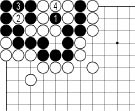 Dia. 5
Dia. 5
In Dia. 1, it seems that Black can kill the White stones with a throw-in at 1. If White captures it as in Dia. 2, his stones will die. Therefore, White must play 2 as in Dia. 3. If Black then captures the two white stones with 3 and White also captures with 4, the resulting position will be almost the same as in the first diagrams. Now Black throws in at 1 as in Dia. 4 and White plays 2. If both players continue this cycle, the game will be declared to be ¡®no result.¡¯ If Black feels that he will win, he can always capture the stone at 2 in Dia. 4 with 3 and and live with a dual life as shown in Dia. 5. If he feels that he will lose, he would be happy to accept a no-result.
Rotten axe
J-ranka (Ñïʯ), C-lanke (Ñïʯ), K-³°¡(Ñïʯ)
A literary name for Go, taken from an Asian ¡®Rip van Winkle¡¯ story of a wood chopper who encountered two immortals playing Go in a forest. He stopped to watch the game, and, when it was finished, he found that his axe had rotten and more than 100 years had passed.
The Chinese ¡®Ñïʯ¡¯ means a ¡®rotten axe handle.¡¯






